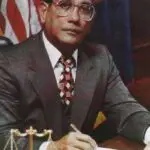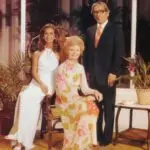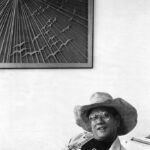


View more images for the Governor Ricardo J. Bordallo entry and Bordallo family collection here.



View more images for the Governor Ricardo J. Bordallo entry and Bordallo family collection here.
Ricardo Jerome Bordallo (1927-1990) was the first popularly elected governor to serve two terms (1975-1978 and 1983-1986). Governor Carlos Camacho had also served two terms though one was an appointed and the other elected. A pioneer of the Guam Democratic Party, Bordallo fought for Guam commonwealth status and invested heavily in modernizing Guam infrastructure. He had also served as chairman of the Popular Party when it sought and received affiliation with the National Democratic Party. The Democratic Party of Guam’s charter was approved at the 1960 Democratic National Convention, the same convention that nominated John F. Kennedy for president.
Bordallo, born 11 December 1927, was the oldest son of BJ Bordallo and Josefina Torres Pangelinan Bordallo of Hagåtña. Bordallo began his education at the Guam Institute. In 1940, he attended George Washington High School (GWHS) until it was closed due to the Japanese invasion of Guam in 1941. Bordallo enrolled at the University of San Francisco after the war with aspirations of becoming a businessman and politician like his father BJ Bordallo. After three years of university, Bordallo returned to Guam to take a position at the family company, Bordallo Consolidated.
Bordallo made his first bid for public office as a senator in the Guam Legislature 1952 at the age of 24. At the time local law required that office holders be at least 25 years old. Bordallo argued successfully that he would be 25 before taking office if he was elected. He was the first to campaign with posters with his photo and handouts with his platform and experience. He lost his first and second campaigns, but won a seat in 1956.
In 1953, Bordallo married future delegate to the US House of Representatives Madeleine Mary Zeien and refocused on his business aspirations. Madeleine was the daughter of GWHS Principal Christian Zeien and business woman Evelyn Zeien. Ricardo and Madeleine had one daughter, Deborah Bordallo, and one grandchild, Nicole Nelson.
Madeleine Bordallo was among the first employees of KUAM Radio and Television, and was a well known media personality long before she ran for elected office, serving first in the legislature and, in 1994, becoming the first female lieutenant governor of Guam, serving with Governor Carl TC Gutierrez. In 2002, she was elected to Congress.
Besides being a businessman Bordallo was also a member of many civic organizations. He led the Marianas Lions Club as well as Ricky’s Suburban Club (a restaurant and bar), the Guam Chamber of Commerce, the American Red Cross, the Navy League of Guam and the Air Force Association of Guam.
Bordallo owned Ricky’s Auto Company, which was the first American distributor for Toyota on Guam. The auto company eventually grew into Ricky’s Enterprises and at its height was valued at $25 million. He had a hand in many different aspects of business life on Guam including finance, publishing, housing, real estate, insurance and tourism.
Failed real estate deals combined with the Oil Crisis in 1973 marked the beginning of a financial decline for Bordallo. His ambitious plan to build a huge resort in Chalan Pago/Yona in partnership with two large Japanese corporations came to a halt when his partners pulled out of the deal and left Bordallo owing millions for land transactions. This occurred between his unsuccessful bid for Guam’s first elected governor election in 1970 and his gubernatorial election victory in 1974.
As a member of the Popular Party Bordallo first won a senate seat in 1956. By the time he ended his legislative career he would win re-election seven times, serving in the fourth through tenth Guam Legislatures. In 1958, he became chairman of the Popular Party and from 1960-1961 became the first chairman for the newly formed Democratic Party. Highlights from this period include his involvement in helping create Guam’s Washington Office and the Elective Governorship Act of 1968, which allowed for the first time governor elections voted on by Guam residents.
Bordallo and running mate Richard F. Taitano won the first Democratic nomination for governor in 1970. A divided base, however, left the door open for the Republican ticket of Carlos Camacho-Kurt Moylan to win the election by an 11.6 percent margin. Camacho was already serving as the last appointed governor of Guam.
In 1973 Bordallo along with running mate Rudolph Sablan and under the guidance of Richard F. Taitano, who was then campaign manager, easily won the democratic nomination in 1974. This time, it was the Republican Party that was split between a Camacho/Moylan and Paul Calvo/Tony Palomo ticket. The divide was enough for Bordallo to take office.
Bordallo came into power during a recession, due in large part to the Arab oil embargo of 1973. The early part of his governorship was spent dealing with internal problems such as a tourism slump, necessary government budget cuts and the short term influx of 100,000 evacuees from Vietnam following the Vietnam War.
Super typhoon Pamela struck in 1976 leaving the island in tatters. Bordallo was successful in securing $367 million for typhoon reconstruction, capital improvement projects and Government of Guam investments. A new building was secured for Guam Memorial Hospital. Tourism development at Tumon Bay began, including new water and sewer lines, sewage treatment plants and new water reservoirs and wells. Transportation was aided by the addition of twenty new miles of highways and eight replaced bridges.
In 1978, with a new lieutenant governor running mate, Dr. Pedro Sanchez, an educator and historian, Bordallo ran for re-election but lost to the Republican team of Paul M. Calvo and Joseph F. Ada amidst a spike in the government deficit. He again returned to the political arena in 1982 with a political unknown, Air Force Colonel Edward Diego Reyes, as his running mate. Promising to guide Guam out of the recession and push for commonwealth status, the Bordallo/Reyes ticket defeated incumbent Governor Calvo in the 1982 elections.
During his second term, Bordallo chaired the Commission for Self-Determination and spearheaded the drafting of the Guam Commonwealth Act developed by 4 June 1986. He addressed Guam’s education problems with his 1983 “Blueprint for Excellence” and worked on the accreditation status of the University of Guam. Controversy met his construction of the Adelup administration facility, now named in his honor, though the former school (Adelup Elementary) had been closed due to the poor condition of the building. Critics questioned the necessity of spending $1.2 million on his “jewel of the Pacific” during tight economic times.
Three days before Bordallo was scheduled to face legislative Speaker Carl TC Gutierrez in the 1986 Guam Democratic Party primary, he was summoned by a federal grand jury on 3 September 1986 and indicted on eleven counts of corruption. He lost the election and on 13 February 1987, Bordallo was found guilty on ten of seventeen counts of extortion, bribery or gratuity, conspiracy and witness tampering. The 9th Circuit overturned eight of the remaining ten convictions in August 1988. Only the convictions on witness tampering and conspiracy to obstruction of justice remained.
Bordallo continued to be involved in politics during this period, focusing his energies on campaigning for approval of the Draft Guam Commonwealth Act and the fight against proposed casino gambling on the island.
After a failed appeal to the US Supreme Court, Bordallo faced a four-year sentence in a federal minimum-security prison beginning on 1 February 1990. Three hours before he was to fly to California on 31 January, Bordallo drove to the Chief Kepuha (also spelled Quipuha) statue at the Paseo Loop. He set up handmade placards that lamented the fractured state of Chamorro control of Guam and reaffirmed his love of the island. He laid out a Guam flag on the ground in front of him and committed suicide with a .38 caliber pistol.
Ige, Ron. “Bordallo Known as Dreamer, Builder: Lived Life of Triumph and Loss.” Pacific Daily News, 1 February 1990.
Maddock, Tambra. “Bordallo Dead: Ex-Governor Commits Suicide at Paseo.” Pacific Daily News, 1 February 1990.
Reyes, Edward Diego. “A Tribute to Governor Ricardo Jerome Bordallo.” In Commemorative Ceremony: Ricardo J. Bordallo Governor’s Complex Adelup. Hagåtña: Ricardo J. Bordallo Governor’s Complex Dedication Ceremony Committee, 1997.
Rogers, Robert. Destiny’s Landfall: A History of Guam. Honolulu: University of Hawai’i Press, 1995.